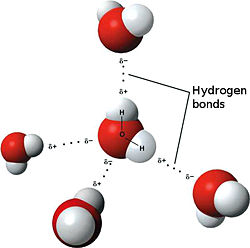Basilisk, the lizard in the video is also called the Jesus Lizard because it can walk on water for about 15 feet when it's weight is about 250 grams. The lizard is able to accomplish this feat by trapping air and water bubbles in a web formation under its feet that assist it to stay above the water surface as long as it keeps moving.
This ability of the Jesus Lizard is a result of the hydrogen bonds that connect water molecules. As shown in the diagram below, the positively charged hydrogen atoms are attracted to the negatively charged oxygen atoms. This
attraction creates a very strong bond, that at the water's surface is responsible for the strong surface tension of water that also assists the Jesus Lizard to walk on the water's surface.
Life Requires Liquid Water
Imagine what would happen if water did not exist as a liquid over the range of temperatures that humans and other life forms can endure. If water at 98.6 degrees Fahrenheit (37 degrees Celsius) was a gas, imagine what would happen to the blood in our veins, the sweat we release, the tears we shed and the rest of the 68% of us that is water. Likewise, imagine if water at 96.6 degrees Fahrenheit (37 degrees Celsius) was a solid. Our saviour, and that of all water-based life, is the Hydrogen Bond.
Hydrogen bonds make water molecules stick together strongly enough to make water freeze at temperatures much lower than it would without them and make water boil at temperatures much higher than that if these bonds did not exist. Scientists tell us that water that boils at 100 degrees Celsius would, without the stickiness of hydrogen bonds, boil at temperatures well below -90 degrees Fahrenheit (-70 degrees Celsius). Life as we know it would not exist without the hydrogen bond.
Water Micro-habitats in the Atmosphere
Hydrogen bonds create the surface tension which, in turn, presents a barrier keeping air and water apart. This separation creates micro-habitats - small regions that contain some special features that suit one (or more) organisms better than it suits other organisms - in the atmosphere. The impact on air-borne organisms when water is extracted from air using biological means needs much further research and study.

No comments:
Post a Comment